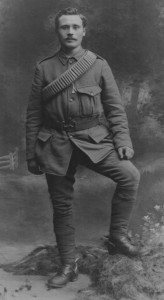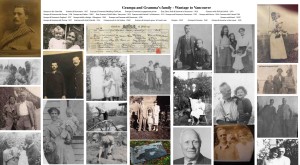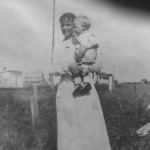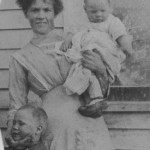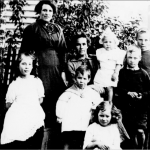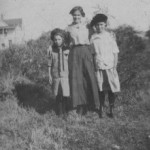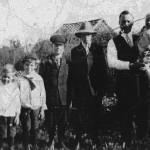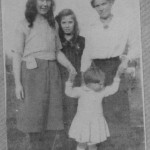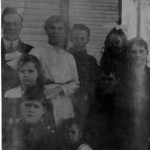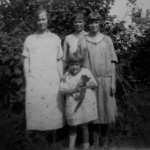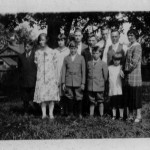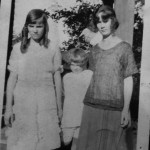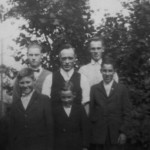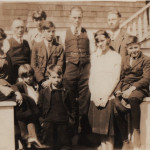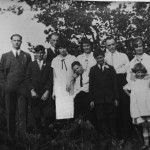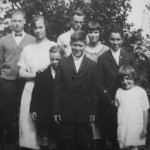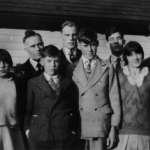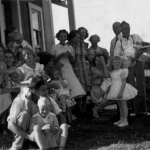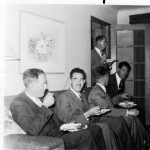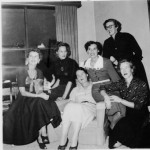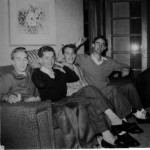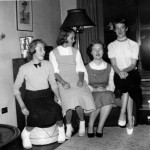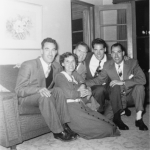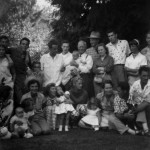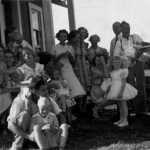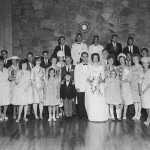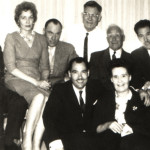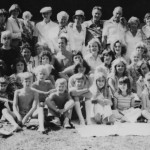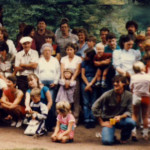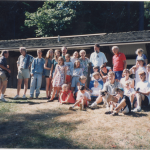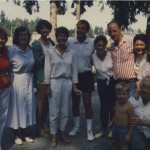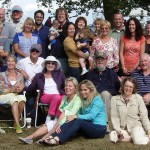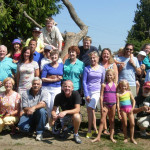Soldier, Sailor, Miller, Baker – the life of John Aldworth West & his family
Click on highlighted text for added information (documents & photos). Click photos to enlarge
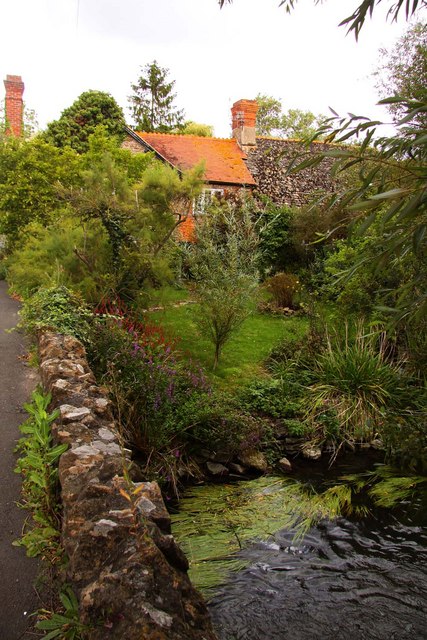
To say our grandfather lived an interesting life would be an understatement. Thanks to a large number of grand-children, all of whom were directly touched by this complicated yet gentle man, and their manifold recollections of him at various points of his “journey”, we know a great deal about him. His travels from England, to South Africa, twice to North America and around the horn of South America are legend in our family.
Yet there are some mysteries about Grampa. To begin with, why does his birth date alternate between 1881 and 1883 on various official documents? (Of course we know that it was 1881 because Grampa used to delight in telling us that it was the same right side up as upside down.) What kind of demons must have stayed with him throughout his life as a result of the shooting at Venn Mill in 1891, or the horrors of war in South Africa and poison gas in France? He was clearly a man of his time, a patriot and an adventurer, who saw his duty to his country and was dramatically lured to the Canadian gold fields. In his later life, we saw him as a loving family man who took us in his self-built clinker boat around Howe Sound, gathered little groups of us, his grandchildren, around him and took us to the PNE – giving us each the treasured 1 dollar bill (which went a long way at that fair in the mid-1950s). We also knew him as a fun-loving man who, if you were brave enough to walk up the stairs to his room on 27th Ave., had humbug candies for us sugar-crazed grandchildren, and if you were lucky enough to sit next to him at a family dinner, would give you the icing off his piece of cake, claiming he didn’t like icing. We remember him also as a religious man. Whether it was the fundamentalism of the Strict Baptist church of his father, the oft-mentioned Church of England on his various military documents or the Presbyterian Church in Edmonton, he always spent Sundays at rest, frequently alone in his room, reading his bible. He also had a secular streak. For our parents, a visit from Grampa meant putting in a garden, the construction of a new paddleboard or raft at Boundary Bay, a bridge over a creek in the back yard at Aldergrove or a pruned tree in Gibsons, using the pen-knife which he always carried with him. And of course, he would never say goodbye without a game of “touched you last”.
Early Years in England
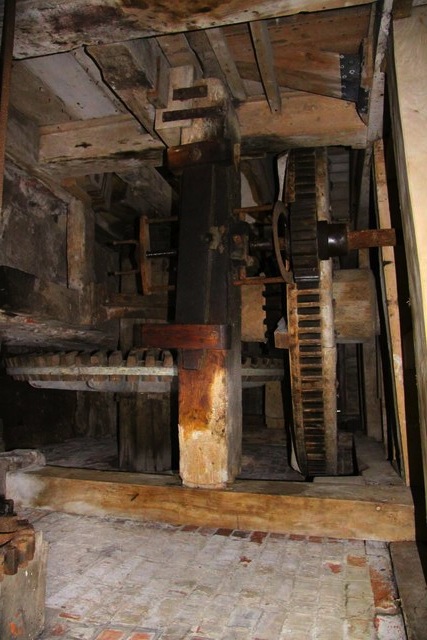
Born in Venn Mill house, he was the 6th of 10 children in a family which modeled the size of his own later in life. It is never a surprise to see such large families in these times, but interestingly, his was the only one of size amongst his siblings. Heber had two children, Percy and Frederick had one each, the rest had no children, and three of the four sisters never married. As a result, we have very few second cousins in our large family. Grampa’s brother Heber came to Canada also, but in spite of a divorce, his daughter Ruth (later referred to as Arlet) in latter years attended several family picnics. Frederick also came to Canada, abandoning his wife Minnie and son Dennis behind in England. Of greatest interest to us all, however, was Percy’s daughter Mary Irish, whose interest in and devotion to her Vancouver cousins was the “glue” to reunite and sustain the history and relationships in our English and Canadian families.
The Gun accident story was told to me in 1994 by Jack Ireson, but it was unknown to any of the Vancouver aunts or uncles. The accident was reluctantly confirmed by Mary Irish a few years later, who said “I can’t tell you which brother it was but it wasn’t my dad” (Percy). From then until 2012, I wondered if it was Grampa. Then during the “kuzzins” visit in 2012, Becky Harris (a “Long” cousin) presented me with a digital copy of an actual Thames Valley Times newspaper article from 1891 which gave the tragic details. Another family story suggested a related ongoing rift between the Venn Mill family and the Lower Hanney Mill family (upstream from Venn). Sometime in the 1890s, the upstream miller (probably Daniel West Jr., Fanny Simmons’ brother) cut off the water to Venn Mill, rendering it inoperable. However, cousin Colin Smith sheds doubt on this story by suggesting that water must go somewhere, and such an action would probably have flooded the adjacent lands in short order.
We can only speculate how much this incident contributed to Grampa’s decision to sign up for military service (age 15) in 1896. Father William Westell West (WWW) apparently “bought him out” shortly thereafter. 3 years later, not needing permission, 18 year old John joined up with the newly formed 58th Company, 15th Battalion Imperial Yeomanry, to fight in the Boer War. It is clear from the documentation that he fought in the Relief of Mafeking, but no records exist showing how much longer he remained in action, other than the fact that the term of his contract was one year. Cousin John West has Grampa’s gold watch, which was presented to him personally by Edward the VII for heroism in the Boer war. The report tells us that as a scout he was wounded with a bullet in his ankle while returning to his regiment to report a Boer position, thereby enabling another British victory. (See also “Steve’s Story” about Grampa as told to him by Uncle Phil. ) We also know that he left for Canada to go to the Klondike Gold Rush, but he was stopped short of his goal by being shanghaiied out of Tacoma and being returned to Dublin some time later that year. Some years ago, cousin Helen had an article in the Victoria Times Colonist on the same subject. Percy told me a story about his planning to accompany Grampa to the Klondike, but he was deterred from doing so by WWW, who when passing by him in a hallway at Venn Mill said, “Get a return ticket boy!”
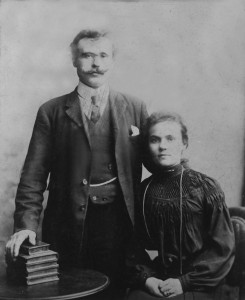 Enter Emma Long. Gramma’s birth dates also vary between 1877 and 1880. She was also born to a large family, the third of six but, unlike Grampa’s family, five of her siblings had full families ranging from 4 to 6 children. Her parents Philip and Harriet Long ran a bakery in East Hanney. She had long hair as a girl. Percy and Grampa John both tried to sit by Emma at school. Grampa “won” her! She married Grampa in 1904 and they lived at Venn Mill. There are Stories of Grampa delivering flour from the Venn Mill to her father Philip Long. It would seem that this is how he met Emmma. Late in 1902 Grampa took over the operation of Venn Mill, and it’s a pretty good guess that his serious courtship of Emma began.
Enter Emma Long. Gramma’s birth dates also vary between 1877 and 1880. She was also born to a large family, the third of six but, unlike Grampa’s family, five of her siblings had full families ranging from 4 to 6 children. Her parents Philip and Harriet Long ran a bakery in East Hanney. She had long hair as a girl. Percy and Grampa John both tried to sit by Emma at school. Grampa “won” her! She married Grampa in 1904 and they lived at Venn Mill. There are Stories of Grampa delivering flour from the Venn Mill to her father Philip Long. It would seem that this is how he met Emmma. Late in 1902 Grampa took over the operation of Venn Mill, and it’s a pretty good guess that his serious courtship of Emma began.
They were married in 1904, Jack was born in 1905 and Elsie in 1907. In 2012, I visited John (our eldest cousin), in Red Deer. At one point he made reference to a comment from Grampa saying that he came to Canada with “Lloyd”. At that point, I had no idea who Lloyd was, but it opened up a whole new area of interest for me.
Click image below for early photos of John & Emma’s family
Emigration to Canada
The history of the trip to Canada and settlement on the prairies is blurry at times, but we know the following from birth certificates, passenger lists and census documents.
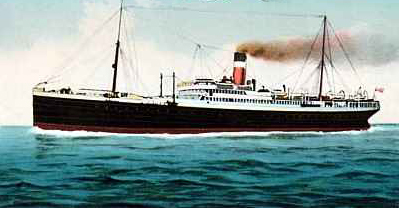
With infants Jack and Elsie the family departed on the S.S. “Corsican” from Liverpool on March 19, 1908 , arriving in Halifax on March 29. Their mode of transportation to Alberta undoubtedly included rail at least as far as Saskatoon. The northern line, Grand Trunk Pacific GTPR, was completed to Saskatoon in 1907 and Edmonton in 1909. It’s more likely they took the Canadian Northern (CNor) via Winnipeg. They lived for a several months in Namao, Alberta, a rural township north of Edmonton, where Phil was born on July 4. It is unclear why they spent this time there except possibly due to the presence of a pioneer family in the area who also bore Gramma’s family name: “Long”. Annie Long was a legendary “angel” in the area, who was instrumental in a number of benevolent activies including founding the area’s first Presbyterian Church. She seems a likely candidate to have had something to do with the family’s sojourn in Namao. Grampa’s family at Venn Mill also had had regular connections with an another “Long” family (William Long) across the field in Garford, who may have provided the Alberta contact. The name Namao was also listed as Grampa’s residence in a curious document: “Canadian South African Service – Application for Volunteer Bounty”. I say “curious” since he only enters his name and town of residence and the rest of the application is crossed out. Perhaps at some point he discovered that this programme required that he be a Canadian citizen at the time of his Boer War service, and he then abandoned the application, but this doesn’t explain why the application was filed. In any case, he filed a regular Canadian homestead application in May of 1909.
Homesteading in Alberta
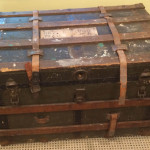
The Alberta Archives office in Edmonton yielded microfilm documents for 2 quarter sections, one registered in Grampa’s name, coordinates: NE24-48-3W4 and another application by Grampa for his brother Frederick (SW24-48-3W4). They show residence from May 5, 1909 until sometime after receiving notification of patent (title) on June 27, 1912, confirming the period of farming. Other family events match this time frame. Edna was born in nearby Lloydminster on July 28, 1910.
Harold was born in 1912 at “Earlie”, the district where the farm was. This area is also known as Paradise Valley. The nearest town and railway station is Kitscoty, 25 km to the north. In February, 2015, we visited the land which has a modern house and farm in the southwest quarter section (Fred’s land), but there was no visible residence on the northeast. (Grampa’s). I have spoken with the current owners and determined that there is a yard site and a well site in the on the northeast section (s.e. corner – see map) and a large (probably 100 year old) maple tree (not indigenous to the area – see photo on homepage). This immediately turned my memory to the story of Grampa bringing a maple sapling to England which he planted in the front yard of Laurel House, Broad Oak, Heathfield, Sussex, the home of his parents (W.W.W. and Sarah). This was possibly during his 1937 visit to attend the Coronation, but as we read the details of his war service, it’s even more possible that he brought it while visiting hisfamily from his army camp at Folkestone in 1915. For the three months while he was stationed there, he was only 50 miles away. After being gassed at Passendale, he was hospitalized at Purfleet, near London, and his England family undoubtedly visited him during this time. It was called the First World War, but the center of action was staggeringly near our family. Auntie Ruth once told me that she could hear the sounds of the artillery in Belgium during those years. They must have been terrifying years. Even Rudyard Kipling in his jingoistic justification of “Empire” and thereby war reveals, in his short stories, the isolation, the desolation and the harsh reality of service experienced by those who came to realize that that they had come out to serve “thankless” years” in alien “lands”.
Grampa and family lived on the farm from May 1909 (with 3 kids) – until at least 1913 (with 5 kids). Fred lived and worked the farm from May to November each year to fulfill his requirements for homestead completion. It is hard to imagine tilling the soil for the first time with a team of oxen not to mention the harsh winters in this part of the world. The documents also reveal the buildings and crop yield for each year, another requirement (in addition to clearing the land) for a successful homestead application. Curiously the family (with 4 kids) appear in the 1911 census as living in Edmonton. The most logical theory is that they bought their house in Edmonton (9724 100th St.) prior to that, living in the city during the winter months of 1911 and 1912, moving back to the farm in the summers (where Harold was born on April 29, 1912). Also strangely, the 1911 census form (although census forms are notorious for inaccuracies), has Elsie born in Alberta (not Venn Mill), and Edna & Phil as born in Saskatchewan. This is not a surprise for Edna since Lloydminster is half in Saskatchewan, but we know Phil was born in Alberta (Namao). Grampa wrote an undated account of taking a load of wheat to sell in Lloydminster, 25 miles away. The fact that the homestead is a similar distance from Lloydminster probably confirms the location and time frame of the family in “Earlie”. Click for article “Sad ending to a homestead”
Back in Edmonton, apparently more permanently, Fred was born on March 7, 1914. My mom’s (Elsie’s) first scrap-book entry is a certificate from 1914 for Sunday School attendance at Ross Flats Presbyterian probably near their house in the present day area of Rossdale. The next entry is a concert programme from 1917 with a delightful listing of mom and Jack as ushers.
Gramma Emma (Long)
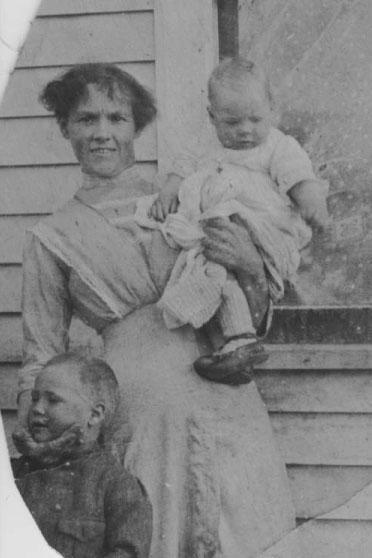
By contrast with Grampa’s exciting life in documents and stories, emma’s family exists in shadow. The fact that she died less than a year before I was born contributes largely to my own perception. But there is much more to it than that.
These circumstances speak to the reality of the war years in which Gramma single-handedly looked after 6 children (and gave birth to a 7th) while having no news from Grampa for months at a time. They also speak to the conditions of war-wives and women who gave birth to large families in pioneer areas such as Alberta in those years. Auntie Marjorie once spoke to me about these issues and told a story of Gramma Emma during the time of the great Edmonton flood of July, 1915. With Grampa off to the First War she was full of despair. With 6 children to take care of and being flooded out of their home, she walked to the river’s edge, took off her wedding ring, and threw it into the river. Edna once told cousin Ann that her first memory was of being carried out of the flooded house by a fireman. Cousin Diane remembers the aunts talking about Gramma living in a sod hut and changing a baby’s diaper (probably Phil since he was born in 1908 and they would have lived in a temporary sod hut before the farmhouse was built in 1910). By the time she had finished changing the baby and reached for the soiled diaper, it was frozen solid). I am left with the sadness that I never knew this wonderful woman and with the words of my own mother in a letter following Gramma’s death from stomach cancer: “the dearest and most unselfish mother in the world”. The growth of this wonderful family during the difficult years of homesteading and Gramma’s single-handed nurturing during the war years show a woman of giant stature!
Grampa’s War Diary – a comprehensive report by Bruce More
First World War – First period of service (May 16, 1915 – November 10, 1915)
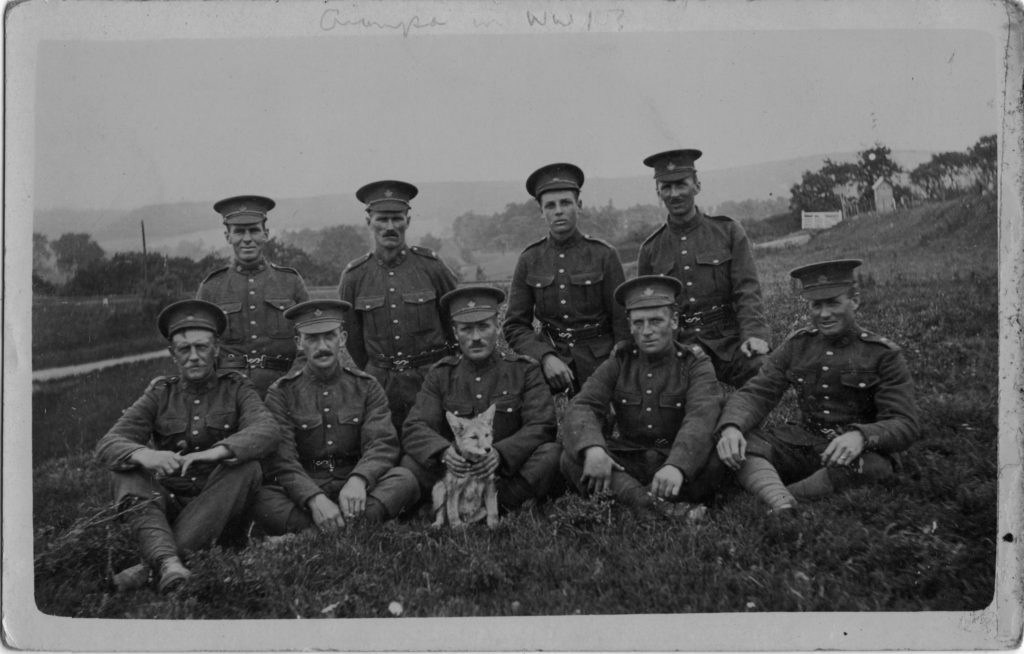
Several documents have been of great assistance in determining Grampa’s war record. Barry had several, including discharge papers from 1915, 1916 and 1918. Grampa’s “Attestation form” from his first sign-up with the Canadian forces (May 16th, 1915 ) confirms his regiment: 49th battalion, (Loyal Edmonton) and his regimental number: 433177 and the dates of his first wartime service. It also shows the family’s address as 9724 100th St, a location which is clearly on the Edmonton River (Ross) Flats, the house which was flooded (shortly after Grampa signed up) in June of 1915.
His regiment left for England in August, training at St. Martin’s Plain, near Folkestone in England until Oct. 8, when the bulk of the regiment was sent to France. According to Grampa’s regimental record, “other ranks (were) transferred to the 9th Battalion” (C.E.F. Canadian Expeditionary Forces) and the rest were “struck off the strength of this battalion”. (see regimental report) This was explained to me as being “held in reserve”. According to his war record, he obtained a medical discharge in November and returned home.
Second Period of Service (January 1 – March 1, 1916)
After his discharge in France, Grampa, “Private John West”, signed up again, this time with the Canadian Active Militia. This seems surprisingly quick given his injury, but during the war this was probably the best way he could support his growing family. The “Attestation form” from this second sign-up with the Canadian forces is dated December 8, 1915, and the address as 1971 79th St., a location south of the centre of the city in an area called Strathcona, probably temporary housing for victims of the flood earlier in the year.
He served as an Internment Camp guard in Jasper, Alberta from January 1 to March 14th, 1916, when he was discharged. (A handwritten note in the upper left corner of the certificate says, “Character Very Good”.) Ken was born in Edmonton on Sept. 25, 1917, and sadly Grampa was not present for the birth.
Third Period of Service (April 17, 1916 – 1918)
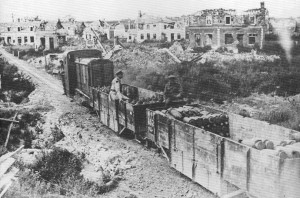
John Aldworth West – regimental # 279533 had signed up for the third time in the war in April of 1916 and was honorably discharged on July 14th, 1918. He served with the 8th Battalion, Canadian Railway Troops, a regiment with a unique mission. (see details above).
The war years and Grampa’s family in England
- Family oral history has Grampa bringing a maple sapling to his mother and father at Heathfield during a visit. It was probably while he was stationed nearby at Folkestone in 1916. In conversation with the current owner of Grampa’s homestead in Earlie, Alberta, I learned that there is a 100 year old maple (not native to Alberta) on the site of their house.
- It is not difficult to see Grampa as a sapper (builder, engineer) during his last period of the war since his duties at Venn Mill would have given him much experience as a builder and mechanic. In fact he lists his occupation in all three attestation papers as “machinist”.
- At some point, we must all have marvelled at the fact that Grampa’s sisters (Emma, Elsie, Mary) never married. However when one considers the effect of close to a million war dead on the young women of this generation in England, it is not surprising.
- It is striking to look at a map of Western Europe and note how geographically close to Heathfield the war was. Auntie Ruth once told me that she could hear the guns during the first war.(Passchendale was less than 100 miles away.) In a letter to Grampa, during the second war, she writes “many German raiders pass over Broad Oak tying to get to London, but many of them fail”. {The German airfield at Dieppe was only 150 miles away).
–
The move to Vancouver
A soldier land settlement railway certificate (#25459), dated June 26, 1919, enables J.A. West (age 37) return travel from Edmonton to Calgary (pte #279533 Battalion 218, a subdivision of the 8th battalion, age 37, discharge certificate #39). We know that the family left Edmonton for Calgary in 1919 and this ticket was probably provided by the war department for vets, possibly related to medical treatment for Grampa’s lung problems.
The family stayed in Calgary (where Ruth was born on May 29, 1919) for only a few months before moving to Vancouver, on the recommendation of physicians. In 1920 they moved to the to Stone House near Elliot St. & 56th Ave., and in 1922 to 161 62nd Ave E., where they lived for six years. During that time, in 1924, Gramma returned for a few months to England to visit her family. The West home was frequented on Sundays by a number of close friends and relatives, notably Charlie and Vera Baker (whom they had met in Edmonton), and of course Heber, Frederick and on occasion Asher and wife Mary. On those occasions, the house was filled with song, the voices of Phil and Fred being particularly remembered. In 1928 they lived for short periods of time on 71st Ave. in Marpole and later on #18 Rd. on Lulu Island. From 1929 until 1937, they lived at 2415 Dunbar St. This was the depression, but both Grampa and Uncle Jack were fortunate enough to work on the “new” Vancouver City Hall and Burrard Bridge during those years. In 1937, both Gramma and Grampa travelled to England for the coronation and in that same year, they moved to 3040 7th Ave, near Balaclava & Bayswater St.
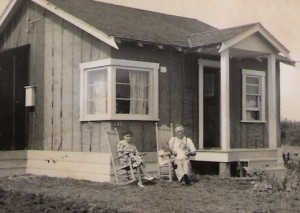
When the family was grown, Gramma and Grampa moved to live with Jack and Margaret on Brighouse Rd., Lulu Island in 1940.
Ann remembers when Gramma got sick, that the kids were not allowed inside. Instead, Grandpa put up an old heavy canvas tent on a wooden base just outside that John, Bill & Ann played in while their mom and dad visited.
In 1941, after a lengthy illness, Grandma died and was buried in Forest Lawn Cemetery. Grampa lived on with various members of the family, and during those years travelled frequently including several trips to Hawaii and the Caribbean. We were all blessed by the 30 years more we spent with him. He died in 1973 and was buried alongside his beloved Emma.
And so the “odyssey” of the West family continues with all us “Kuzzins” and our families. The success of the West brothers and sisters has been legendary and there are (John) Wests all over Western Canada to prove it and the family just grows & grows & grows…..
(Click below to enlarge family pictures from 1910 to 2014)
Enigmas
- Birthdates:
- Grampa’s Marriage certificates give his birth date as 1881, the 1908 passenger list gives his age as 24 – therefore born in 1884. The 1911 census says age 28 or born in 1883 and the 1921 census says age 40 or born in 1981. Both Attestation papers list his birth date (in his own handwriting) as 1883. His 1916 discharge paper from the Active Militia, gives his age as 34 or born in 1882.
- Gramma’s Marriage certificates give her birth date as 1877, the 1908 passenger list gives her age as 28 – therefore born in 1880. The 1911 census says age 31 or born in 1880 and the 1921 census says age 40 or born in 1881.
- Names used: Elsie’s autograph book has a note “to Lally”. In addition, Great Auntie Ruth wrote a poem in the 20s about the Vancouver family, naming each child except Elsie, but including the name “Lally”.
